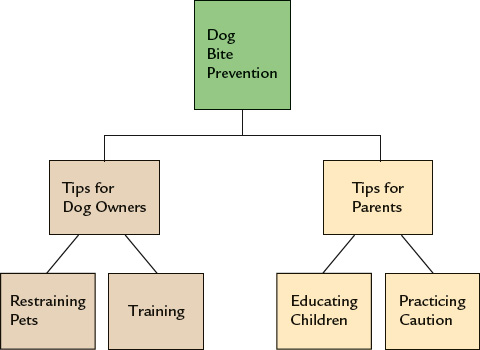7eMake a plan.
At this point, you will find it helpful to create an organizational plan or outline. To do so, simply begin with your thesis; review your exploratory notes, research materials, and visuals; and then list all the examples and other good reasons you have to support the thesis.
A sample organizational plan
One informal way to organize your ideas is to figure out what belongs in your introduction, body paragraphs, and conclusion. Here is how one student, who was writing about solutions to a problem, used this kind of plan:
WORKING THESIS
Increased motorcycle use demands the reorganization of campus parking lots.
INTRODUCTION
give background and overview (motorcycle use up dramatically) and use a photograph of overcrowding in a lot
state purpose—to fulfill promise of thesis by offering solutions
BODY
describe the current situation (tell of my research at area parking lots)
describe the problem in detail (report on statistics; cars vs. cycles) and include a graph representing findings
present two possible solutions (enlarge lots or reallocate space)
CONCLUSION
recommend against first solution because of cost and space
recommend second solution, and summarize benefits of it
A formal outline
Even if you have made an informal written plan before drafting, you may also want—or be required—to prepare a formal outline, which can help you see exactly how the parts of your writing will fit together—how your ideas relate, where you need examples, and what the overall structure of your work will be. Most formal outlines follow a conventional format of numbered and lettered headings and subheadings, using roman numerals, capital letters, arabic numerals, and lowercase letters to show the levels of importance of the various ideas and their relationships. Each new level is indented to show its subordination to the preceding level.
Thesis statement
- First main idea
- First subordinate idea
- First supporting detail or point
- Second supporting detail
- Third supporting detail
- Second subordinate idea
- First supporting detail
- Second supporting detail
- First subordinate idea
- Second main idea
- First subordinate idea
- First supporting detail
- Second supporting detail
- Second subordinate idea
- First supporting detail
- Second supporting detail
- First supporting detail
- Second supporting detail
- First subordinate idea
Note that each level contains at least two parts, so there is no A without a B, no 1 without a 2. Also keep in mind that headings should be stated in parallel form—either all sentences or all grammatically parallel structures.
A storyboard
The technique of storyboarding—working out a narrative or argument in visual form—can be a good way to come up with an organizational plan, especially if you are developing a Web site or other multimedia project. For such projects you can even find storyboard templates online to help you get started.
For a typical college essay, however, you can create your own storyboard by using note cards or even sticky notes, taking advantage of different colors to keep track of threads of argument, subtopics, and so on. Remember that flexibility is a strong feature of storyboarding: you can move the cards and notes around, trying out different arrangements, until you find an organization that works well for your writing situation. Basic patterns for a storyboard include linear, hierarchical, and spoke-and-hub organization.
LINEAR ORGANIZATION
Use this when you want most readers to move in a particular order through your material. An online report might use the following linear organization:

HIERARCHICAL ORGANIZATION
A hierarchy puts the most important material first, with subtopics branching out from the main idea. A multimedia presentation on dog bite prevention might be arranged like this:

SPOKE-AND-HUB ORGANIZATION

A spoke-and-hub organization allows readers to move from place to place in no particular order. Many portfolio Web sites are arranged as shown at right:
Whatever form your plan takes, you may want or need to change it along the way. Writing has a way of stimulating thought, and the process of drafting may generate new ideas. Or you may find that you need to reexamine some data or information or gather more material.